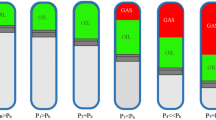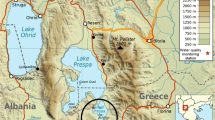Abstract
An energy storage operation chart (ESOC) is one of the most popular methods for conventional cascade reservoir operation. However, the problem of distributing the total output obtained from the ESOC has not yet been reasonably solved. The discriminant coefficient method is a traditional method for guiding the output distribution by determining the order of reservoir supply or storage; however, it cannot quantify the water used in operation. Thus, this study develops a new output distribution model using a polynomial fitting method and an artificial neural network to express the functional relationship derived from the deterministic optimization results of long-term runoff series to maximize power generation. Cascade reservoirs of the lower reaches of the Jinsha River in China were selected for the case study. Compared to the discriminant coefficient method, the proposed method can rationally distribute the total output, thus avoiding the problem of concentrated deserting water in downstream reservoirs that occurs in the discriminant coefficient method. In general, this study proposes an effective alternative method to guide cascade reservoir operation.






Similar content being viewed by others
Availability of Data and Materials
All data and codes are available from the corresponding author.
References
Anand R, Aggarwal D, Kumar V (2017) A comparative analysis of optimization solvers. J Stat Manag Syst 20(4):623–635
Buyukyildiz M, Tezel G, Yilmaz V (2014) Estimation of the change in lake water level by artificial intelligence methods. Water Resour Manage 28(13):4747–4763
Chen J (2021) Long-term joint operation of cascade reservoirs using enhanced progressive optimality algorithm and dynamic programming hybrid approach. Water Resour Manage 35(7):2265–2279
Cheng C, Yang F, Wu X, Su H (2010) Link the simulation with dynamic programming successive approximations to the study on optimal operation chart of cascade reservoirs. J Hydroelectric Eng 29(6):71–77
Cheng CT, Wang WC, Xu DM, Chau KW (2008) Optimizing hydropower reservoir operation using hybrid genetic algorithm and chaos. Water Resour Manage 22(7):895–909
Coulibaly P, Anctil F, Bobee B (1999) Hydrological forecasting with artificial neural networks: the state of the art. Can J Civ Eng 26(3):293–304
Csáji BC (2001) Approximation with artificial neural networks. Etvs Lornd University, Hungary 24(48):7
Howson H, Sancho N (1975) A new algorithm for the solution of multi-state dynamic programming problems. Math Program 8(1):104–116
Ji C, Jiang Z, Sun P, Zaho B, Zhou T (2014) Study on cascade energy storage dispatching figure based on discriminant criterion method and progressive optimality algorithm. J Hydroelectric Eng 33(3):118–125
Jiang ZQ, Ji CM, Sun P, Wang LP, Zhang YK (2014) Total output operation chart optimization of cascade reservoirs and its application. Energy Convers Manage 88:296–306
Jiang ZQ, Li AQ, Ji CM, Qin H, Yu S, Li YZ (2016) Research and application of key technologies in drawing energy storage operation chart by discriminant coefficient method. Energy 114:774–786
Jiang ZQ, Liu P, Ji CM, Zhang HR, Chen YY (2019) Ecological flow considered multi-objective storage energy operation chart optimization of large-scale mixed reservoirs. J Hydrol 577
Labadie JW (2004) Optimal operation of multireservoir systems: State-of-the-art review. J Water Resour Plan Manag 130(2):93–111
Li X, Cui W, Guo Y, Yu X, Zhang M (2022) Research and application for drawing method of multilevel reservoir operation chart. J Tianjin Univ 55(3):322–330
Liu X, Guo S, Li X, Li Y (2011) Flood control operation chart for Three Gorges Reservoir considering errors in inflow forecasting. Adv Water Sci 22(6):771–779
Liu Y, Jiang Z, Feng Z, Chen Y, Zhang H, Chen P (2019) Optimization of energy storage operation chart of cascade reservoirs with multi-year regulating reservoir. Energies 12(20)
Meng FC, Chu DH, Li KQ, Zhou XQ (2019) Multiple-class multidimensional knapsack optimisation problem and its solution approaches. Knowl-Based Syst 166:1–17
Sharghi E, Nourani V, Najafi H, Molajou A (2018) Emotional ANN (EANN) and Wavelet-ANN (WANN) approaches for Markovian and seasonal based modeling of rainfall-runoff process. Water Resour Manage 32(10)
Wan WH, Wang H, Zhao JS (2020) Hydraulic potential energy model for hydropower operation in mixed reservoir systems. Water Resour Res 56(4)
Wan WH, Zhao JS, Popat E, Herbert C, Doll P (2021) Analyzing the impact of streamflow drought on hydroelectricity production: a global-scale study. Water Resour Res 57(4)
Wang S, Jiang Z, Liu Y (2022) Dimensionality reduction method of dynamic programming under hourly scale and its application in optimal scheduling of reservoir flood control. Energies 15(3)
Wang X, Pang J, Lei X, Tian Y, Jiang Y (2010) Overview of reservoir operation chart optimization. South-to-North Water Trans Water Sci Technol 8(5):71–75
Zeng Y, Wu XY, Cheng CT, Wang YQ (2014) Chance-constrained optimal hedging rules for cascaded hydropower reservoirs. J Water Resour Plan Manage 140(7)
Zhang R, Zhang L, Wang X, Wang Y (2016a) Model and application of multi-objective beneficial dispatch for cascade reservoirs in Jinsha River. J Sichuan Univ. Eng Sci Ed 48(4):32–37, 53
Zhang W, Huang Y (2020) Using big data computing framework and parallelized PSO algorithm to construct the reservoir dispatching rule optimization. Soft Comput 24(11):8113–8124
Zhang W, Liu P, Chen X, Wang L, Ai X, Feng M, Liu D, Liu Y (2016b) Optimal operation ofmulti-reservoir systems considering time-lags of flood routing. Water Resour Manage 30(2):523–540
Zhu Y, Zhou J, Qiu H, Li J, Zhang Q (2021) Operation rule derivation of hydropower reservoirs by support vector machine based on grey relational analysis. Water 13(18)
Funding
This study was financially supported by the Natural Science Foundation of China (52179016), the Natural Science Foundation of Hubei Province (2021CFB597), and the Key Program of the National Natural Science Foundation of China (U1865202).
Author information
Authors and Affiliations
Contributions
Yuxin Zhu, Jianzhong Zhou, and Yongchuan Zhang: conceptualization, methodology, supervision, writing, investigation, funding acquisition, and programming. Zhiqiang Jiang, Benjun Jia, and Wei Fang: review, formal analysis, and visualization. Shuai Liu: data curation and programming.
Corresponding authors
Ethics declarations
Ethics Approval
The author promises to comply with Ethical Standards.
Consent to Participate
Not applicable.
Consent to Publish
Not applicable.
Competing Interests
The authors declare no competing interests.
Additional information
Publisher's Note
Springer Nature remains neutral with regard to jurisdictional claims in published maps and institutional affiliations.
Rights and permissions
Springer Nature or its licensor holds exclusive rights to this article under a publishing agreement with the author(s) or other rightsholder(s); author self-archiving of the accepted manuscript version of this article is solely governed by the terms of such publishing agreement and applicable law.
About this article
Cite this article
Zhu, Y., Zhou, J., Zhang, Y. et al. Optimal Energy Storage Operation Chart and Output Distribution of Cascade Reservoirs Based on Operating Rules Derivation. Water Resour Manage 36, 5751–5766 (2022). https://doi.org/10.1007/s11269-022-03333-8
Received:
Accepted:
Published:
Issue Date:
DOI: https://doi.org/10.1007/s11269-022-03333-8




